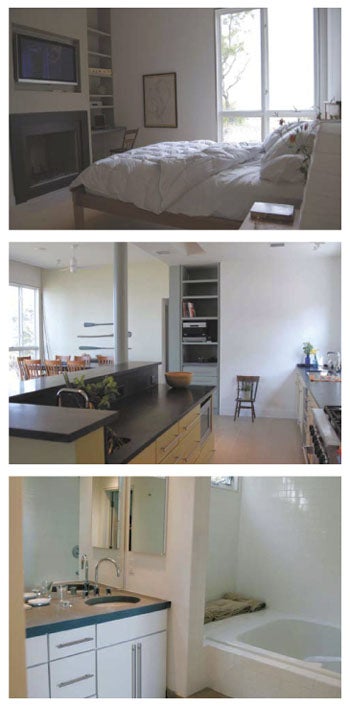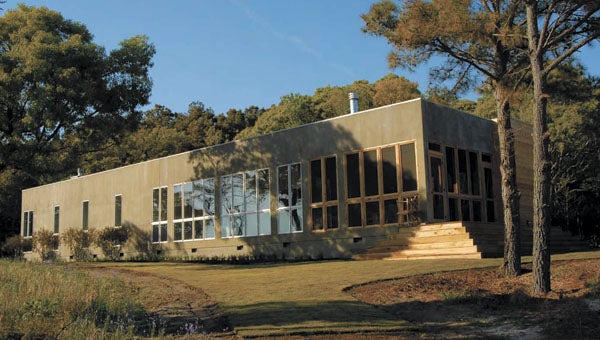Sand & woods
Published 5:33 pm Wednesday, October 6, 2010
By Lauren Wicks
This Eastern Shore getaway won’t be stereotyped
There is no easy way to define Pickett’s Harbor Beach House.
From its layout and design to its decor and location, the home is a sweet revelry of simple complexities.
Staying in the four-bedroom home, guests are transported back into the history of the Eastern Shore of Virginia, yet all the while they enjoy the benefits of a sleek and contemporary home design.
The stillness and solitude of a 27-acre private beach take precedence, but the details of the home lend themselves to times of community and family.

TOP: All four bedrooms in the Pickett’s Harbor Beach House feature views of the water and decorations that evoke Eastern Shore memories. CENTER: New and old come together in the kitchen/dining area, where antique paddles adorn the walls and kitchen cabinets have a sleek, modern feel. BOTTOM: Bathrooms and other utility areas in the home face the woods, leaving the shore-side space for living areas, each of which is afforded a view of the water.
And while the home opens itself to the crowded woods of the Shore’s interior, the entire house lies facing the water — every wave that crests at the beach can be seen by someone from the home.
Pickett’s Harbor is located directly on the Chesapeake Bay, in Cape Charles, Va. The Shore is accessible via the historic Chesapeake Bay Bridge Tunnel, and famous for its fishing, kayaking and water trails.
The Eastern Shore is a 70-mile-long peninsula trenched in history, and it is where Tom Goffigon, the architect of Pickett’s Harbor, grew up.
“I wanted the focus to be on the geography,” Goffigon said. “I wanted the focus to be on the Chesapeake Bay, the beach and the woods.”
Goffigon achieved his dream through both the location and the design of the house.
The home is nestled in the woods Cape Charles, but it was built so every room has a view of the waterfront. The utility rooms (kitchen, bathrooms and laundry room) are in the front of the house, facing the woods. Each of the bedrooms and social spaces (great room and dining areas) faces the water.
“Every room always has an orientation back to the beach,” Goffigon said. “You always have a view of the water, and that’s probably one of my favorite things about the house.”
Following his objective to highlight the Shore at its natural best, Goffigon built the one-story house to respect the environment in which it resides. Unlike many new construction projects that call for bigger houses and more visibility, Pickett’s Harbor creates almost a sense of anonymity. The house is located far enough off the beach and set low enough that is almost unseen from the water.
“It becomes invisible,” Goffigon said. “From the beach itself, you cannot see the house. It is totally respectful of its setting.”
Even the home’s exterior was crafted to highlight the Shore’s geography. The half of the home facing the woods is sheathed in cedar planks; the half facing the water is covered in light-colored stucco. The corresponding materials neatly camouflage the home in its natural environment.
“It was a pretty straightforward fusion between the actual materials on site,” Goffigon said. “To me, it reinforces the simplicity of the beach and the land.”
Goffigon described his design for the house as contemporary, with floor-to-ceiling windows, no wood trim around the windows or doors and bamboo floors throughout the home.
His choice of design elements, however, seemed more inspired by the history of the Eastern Shore.
At every turn and corner of the home, there are relics of the peninsula. Old photos, fishing reels and maps of the Shore adorn the walls. Bookshelves hold decoy ducks and woodwork native to the area. The kitchen cabinets are topped off by glass jars and oyster tins from local businesses.
“The Eastern Shore was settled in 1609, so I wanted there to be a lot of clear, historic references throughout the house,” Goffigon said.
He even hand-selected the home’s furniture to be sure it fit the old Shore feeling.
“I picked furniture I like to think of as a nice fit between beach casual/informal, but reflected my upbringing here,” he said.
Each of the bedrooms exudes a simplicity that seems to echo the simple way of life on the Eastern Shore. Light-colored walls and bedding are highlighted by specific Shore pieces as if to remind the visitor of the environment. In one bedroom, photographic negatives of the house have been blown up and hung. In another, there is an antique wooden croquet set.
The decoration is crisp and clean, as well as comfortable and peaceful, which highlights one of the property’s biggest assets, its tranquility.
“The house appeals to people who like nature and the beach,” said Sara Goffigon, Tom’s mother and caretaker of the house. “But mostly people come out here and are so impressed with how peaceful it is. It is very quiet here, and it’s very relaxing.”
Guests are always surprised by how private the beach really is.
“There is not much private beach on the East Coast, and we’re hidden in the woods and the beach, so there is a nice serenity here,” Sara said. People will come out here and say ‘How in the world did you find this place?’ I laugh, because we didn’t find it, we just grew up here.”
Goffigon’s family has deep roots on the Eastern Shore. In the 17th century, Goffigon’s ancestors, the Nottinghams, were granted a large parcel of land by the King of England. The land has been passed down, generation by generation.
“We certainly have enjoyed it,” Sara said.
The land has also served as one of Tom Goffigon’s greatest inspirations.
“I always knew I would build a house on the land,” he said. “This house was meant to be.”
Tom did his undergraduate studies at the University of Virginia and graduate work at Harvard. He now lives in Los Angeles, where he works as an architect. Despite being 3,000 miles away, Tom said, the Eastern Shore still resonates with him.
“I grew up on the Eastern Shore, and I am fascinated by it,” he said. “Just the relationship between the land and the water and the flatness of the shore has always appealed to me.”
When Tom began designing Pickett’s Harbor five years ago, he set out on a mission to make that geography shine. Additionally, he wanted people to be able experience a relaxing environment while enjoying the land he so loves.
“It’s truly a getaway from it all,” Tom said. “Once people come and find it, they always want to come back.”
While the remote location of the house is a perk, guests should not feel isolated within the home. Goffigon built the home for his family to have a place to celebrate the area together.
There are indoor and outdoor dining areas. The outdoor area is completely screened, with a built-in grill and sink for easy meal preparation. Along the sides of the room facing the woods, there are cushioned window seats for additional seating. Through the porch, the Chesapeake Bay Bridge Tunnel is fully visible, making planning trips into nearby Norfolk, Virginia Beach or Williamsburg even more plausible.
From the screened-in porch, guests can take the wood-planked trail directly to the waterfront.
From the woods to the beach.
From the social dining hall to the empty shores.
From the contemporary home to the historic waters.
All are but steps away from guests at Pickett’s Harbor beach house.
The Pickett’s Harbor Beach House is rented year-round. For more information about the home, visit www.phbeachhouse.com.



